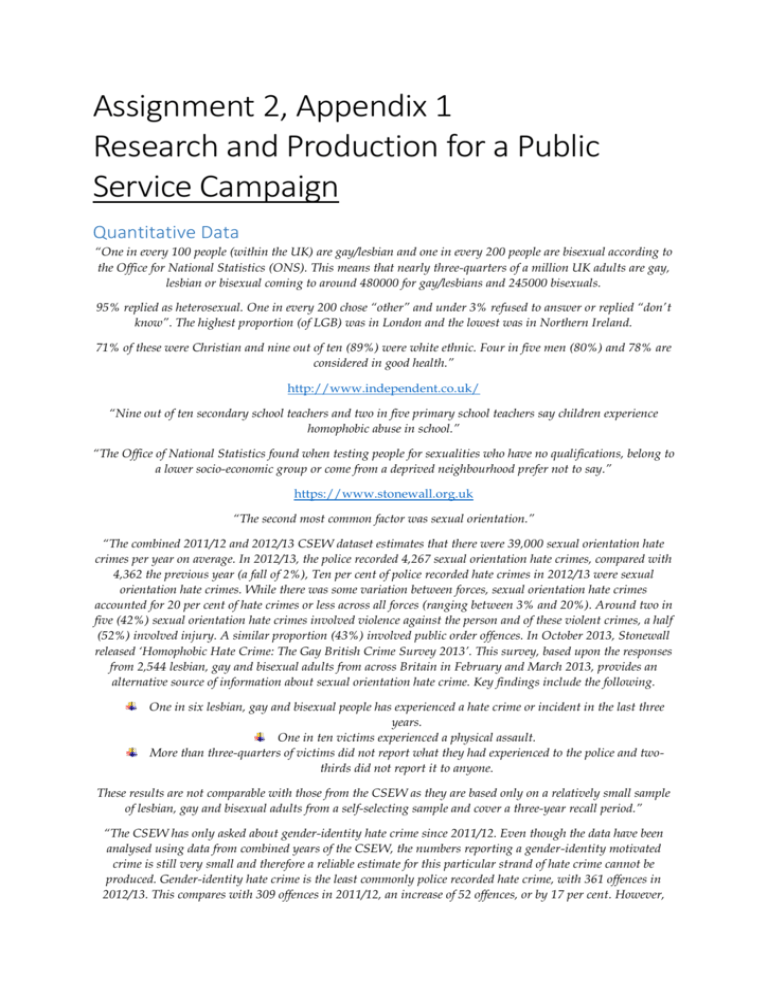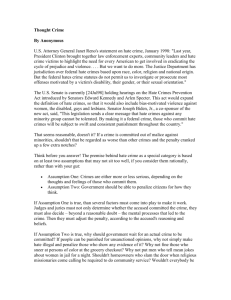
Assignment 2, Appendix 1
Research and Production for a Public
Service Campaign
Quantitative Data
“One in every 100 people (within the UK) are gay/lesbian and one in every 200 people are bisexual according to
the Office for National Statistics (ONS). This means that nearly three-quarters of a million UK adults are gay,
lesbian or bisexual coming to around 480000 for gay/lesbians and 245000 bisexuals.
95% replied as heterosexual. One in every 200 chose “other” and under 3% refused to answer or replied “don’t
know”. The highest proportion (of LGB) was in London and the lowest was in Northern Ireland.
71% of these were Christian and nine out of ten (89%) were white ethnic. Four in five men (80%) and 78% are
considered in good health.”
http://www.independent.co.uk/
“Nine out of ten secondary school teachers and two in five primary school teachers say children experience
homophobic abuse in school.”
“The Office of National Statistics found when testing people for sexualities who have no qualifications, belong to
a lower socio-economic group or come from a deprived neighbourhood prefer not to say.”
https://www.stonewall.org.uk
“The second most common factor was sexual orientation.”
“The combined 2011/12 and 2012/13 CSEW dataset estimates that there were 39,000 sexual orientation hate
crimes per year on average. In 2012/13, the police recorded 4,267 sexual orientation hate crimes, compared with
4,362 the previous year (a fall of 2%), Ten per cent of police recorded hate crimes in 2012/13 were sexual
orientation hate crimes. While there was some variation between forces, sexual orientation hate crimes
accounted for 20 per cent of hate crimes or less across all forces (ranging between 3% and 20%). Around two in
five (42%) sexual orientation hate crimes involved violence against the person and of these violent crimes, a half
(52%) involved injury. A similar proportion (43%) involved public order offences. In October 2013, Stonewall
released ‘Homophobic Hate Crime: The Gay British Crime Survey 2013’. This survey, based upon the responses
from 2,544 lesbian, gay and bisexual adults from across Britain in February and March 2013, provides an
alternative source of information about sexual orientation hate crime. Key findings include the following.
One in six lesbian, gay and bisexual people has experienced a hate crime or incident in the last three
years.
One in ten victims experienced a physical assault.
More than three-quarters of victims did not report what they had experienced to the police and twothirds did not report it to anyone.
These results are not comparable with those from the CSEW as they are based only on a relatively small sample
of lesbian, gay and bisexual adults from a self-selecting sample and cover a three-year recall period.”
“The CSEW has only asked about gender-identity hate crime since 2011/12. Even though the data have been
analysed using data from combined years of the CSEW, the numbers reporting a gender-identity motivated
crime is still very small and therefore a reliable estimate for this particular strand of hate crime cannot be
produced. Gender-identity hate crime is the least commonly police recorded hate crime, with 361 offences in
2012/13. This compares with 309 offences in 2011/12, an increase of 52 offences, or by 17 per cent. However,
due to the relatively low number of police recorded gender-identity hate crimes, care should be taken in
examining trends in this type of hate crime. For example, in 2010 the police in England and Wales recorded 352
gender-identity hate crimes, similar to the 2012/13 figure. Around one per cent of all police recorded hate crime
is gender-identity hate crime, with the proportion of offences of this type below five per cent of all hate crime
across all forces. Just under a half (47%) of gender-identity hate crimes were public order offences and a third
(32%) were violence against the person offences”
An Overview of Hate Crime in England and Wales
Home Office, Office for National Statistics and Ministry of Justice
“LGBPTTQQIIAA+: a near exhaustive string of letters to attempt to represent all the identities in the queer
communities. It stands for “Lesbian, Gay, Bisexual, Pansexual, Transgender, Transsexual, Queer, Questioning,
Intersex, Intergender, Asexual and Ally.”
“Ally: a heterosexual and/or cis person who supports the queer community.”
“Androgyny: a gender expression which features masculine and feminine elements, often used as a place hold
for intersex.”
“Asexual: a person who doesn’t experience or has very little sexual attraction towards any group of people and
often only has romantic attractions.”
“Bigender: a person who changes between traditionally male and female gender identities with sometimes a
third gender. They identify as both genders. Not to be confused with fluid(ity).”
“Binary Gender: an outdated view that was limited to male and female.”
“Bisexual: someone who has romantic and sexual attractions to people of their own gender as well as another
gender. This usually is the genders of male and female and often is confused with pansexual.”
“Cisgender: a description of someone whose gender identity/expression matches their biological body.”
“Cissexism: behaviour that grants preferential treatment towards cisgender as them being more “right” than
other sexualities, often leading to ignoring and or bullying the queer community as well as not taking them
seriously.”
“Fluid(ity): this describes someone who fluctuates between different sexualities and or gender identities. Not to
be confused with transitioning or bigender.”
FTM / MTF: simply standing for Female To Male and Male to Female. This is someone who has medically
undergone the sex change process or are in the process of doing so.”
“Gay: a man who is attracted to another man, however is also coined by lesbian women.”
“Gender expression: the external display of gender identity through clothes, personality, social behaviour and
other scales. Generally measured via masculinity and femininity.”
“Genderless: someone who doesn’t identify with any gender.”
“Genderqueer: an outdated term to blanket everyone who falls out of the gender binary. It is also a person who
identifies as both man and woman or neither. It can also be used in exchange for transgender.”
“Hermaphrodite: an outdated medical term for someone who is intersex.”
“Heterosexism: behaviour that grants preferential treatment towards heterosexuals as them being more “right”
than other sexualities, often leading to ignoring and or bullying the queer community as well as not taking them
seriously.”
“Homophobia: fear, hatred, intolerance or discomfort around and or towards queers. Can often be focused
internally against their own sexuality.”
“Homosexuality: the medical term for a person who is attracted to the same gender or sex. This can be
considered offensive, often used incorrectly in the place of lesbian/gay.”
“Hypersexuality: sexual attractions where the intensity borders insatiable or an addiction.”
“Intersex: a person with sexual anatomy that doesn’t fit within the labels of male or female.”
“Pansexual: someone who has romantic and sexual attractions to all sexualities and gender
expressions/identities. Not to be confused with polysexual.”
“Queer: originally derogatory slang, the LGBTQ+ community accept it as a symbol of pride and represents
everyone who falls out of the sexual and gender “norms”.”
“Questioning: the process of exploring one’s own sexuality.”
“Same Gender Loving (SGL): a phrase coined by the African American / Black queer community to be used as
an alternative for lesbian and gay.”
“Sexual Preference: the illusion that people have a “choice” or “preference” to who they are attracted to, also
used to describe the types of sexual intercourse, stimulation and gratification they like to participate in.”
“Skoliosexual: someone who has romantic and sexual attractions to genderqueer and transsexual identities
(those who aren’t cisgender).
Skoliosexism: behaviour that grants preferential treatment towards skoliosexuals as them being more “right”
than other sexualities, often leading to ignoring and or bullying the cis community as well as not taking them
seriously.”
“Straight: a man or a woman who is attracted to the other binary gender. Often referred to as heterosexual.”
“Third Gender: someone who doesn’t identity as one of the binary genders.”
“Transgender: a blanket term to cover all who aren’t cisgender, often used as transgendered which is incorrect
as the “er” is misleading, as it implies something happened to the person to make them transgender.”
“Transsexual: a person whose gender identity is the binary opposite of their biological sex and may undergo
medical treatments to align these.”
“Transvestite: a person who dresses as the binary opposite of their gender expression (cross-dressing) for many
different reasons such as relaxation, fun and sexual gratification. Often confused with transsexual.”
http://itspronouncedmetrosexual.com/
“Polysexual: a different term for bisexual to include the genderqueer and transsexual as well as binary genders
to be attracted to. Not to be confused with pansexual.”
http://answers.yahoo.com/
“Demisexual: a form of asexualism where no sexual attracts will be experienced until they form a strong
emotional connection with them.”
http://www.asexuality.org/
“In 2012, 22% of people within the UK said that homosexuality was wrong.”
http://www.bsa-30.natcen.ac.uk/
Qualitative Data
Public Opinions
Same sex marriages should be legalised
Unfortunately, there is a vast majority of the population that is still homophobic
Views
Same sex marriages are being more widely accepted across the world, in several countries it
being legalised
The recent Pope is supportive of the LGBTQ+ community
Attitudes
Hate crimes towards the queer community are taken more seriously by the police and has
been made an offense just like xenophobia
In the United Kingdom, Section 28 of the 1988 Local Government Act banned "promotion of
homosexuality as a pretended family relationship" by local government employees in the
course of their duties. The act was aimed to prevent the "promotion of homosexuality" in
schools. It was later repealed by the Conservative government, which also issued an apology
to LGBT people for the act.
If we were making a commercial product, we would be targeting the ABC1 target audience as they
own disposable income to buy products.
Evaluate Sources
My sources are from the internet from a range of different website. Although this can lead to them
being more accurate, as there is lots of different places to cross reference the validity of statements
and definitions. When it comes to bias, there isn’t much room for it however there can be what that
one particular website thinks is the “right” definition of being a certain GID although they are mostly
left up to individual interpretation mostly past the definition itself.
Although it isn’t so much online, in other forms of media there is a large gap in the market in any
information concerning gender identity due to the fact that it isn’t seen as an important thing and
insignificant in comparison to other issues.
Because of the fact that I will be aiming my leaflet at young adults, also known as the E1C1C2 classes,
I will write in a mixture of peer-to-peer as well as teacher-to-student as it is an informative leaflet.






